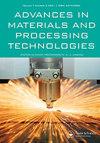Piezoelectricity and electrochemical effect of PVDF thermoplastic-based composites
IF 2.1
Q3 MATERIALS SCIENCE, MULTIDISCIPLINARY
Advances in Materials and Processing Technologies
Pub Date : 2023-09-20
DOI:10.1080/2374068x.2023.2259142
引用次数: 0
Abstract
ABSTRACTPolyvinylidene fluoride (PVDF) is a very high rendering polymer with a great performance of actuation and exceptionally good chemical and thermal resistance. The polymerisation of vinylidene difluoride produces PVDF, which is a highly non-reactive thermoplastic fluoropolymer. Due to its higher flexibility and piezoelectric properties, fabrications of PVDF-based nanocomposites are much in demand today and have found lots of applications in next-generation sensing objects such as promising piezoelectric energy harvesters (nanogenerators), energy storage devices, sensor systems, and biomedical devices. In this work, a brief review of the nature and characteristics of PVDF-based polymers has been discussed. Besides some manufacturing methods for nanocomposites, ways to improve PVDF phase crystallinity (α, β) and nanocomposite qualities are also reviewed.KEYWORDS: PVDFCNT (carbon nanotubes)MWCNT (multi-walled carbon nanotubes)SWCNT (single-walled carbon nanotube)BaTiO3 (barium titanium oxide) AcknowledgementsThe authors are highly thankful to Mechanical Engineering Department and University Centre for Research and Development, Chandigarh University, for technical support in this manuscript.Disclosure statementNo potential conflict of interest was reported by the author(s).PVDF热塑性复合材料的压电和电化学效应
摘要聚偏氟乙烯(PVDF)是一种高性能聚合物,具有良好的致动性能和耐化学性和耐热性。二氟乙烯聚合产生PVDF,这是一种高度非反应性的热塑性含氟聚合物。由于其更高的灵活性和压电性能,pvdf基纳米复合材料的制造在今天非常受欢迎,并且在下一代传感物体中得到了广泛的应用,例如有前途的压电能量收集器(纳米发电机)、能量存储设备、传感器系统和生物医学设备。本文简要介绍了pvdf基聚合物的性质和特点。综述了PVDF相结晶度(α, β)和纳米复合材料质量的改善方法。关键词:PVDFCNT(碳纳米管)MWCNT(多壁碳纳米管)SWCNT(单壁碳纳米管)BaTiO3(氧化钛钡)致谢作者非常感谢昌迪加尔大学机械工程系和大学研究与发展中心对本文的技术支持。披露声明作者未报告潜在的利益冲突。
本文章由计算机程序翻译,如有差异,请以英文原文为准。
求助全文
约1分钟内获得全文
求助全文
来源期刊

Advances in Materials and Processing Technologies
MATERIALS SCIENCE, MULTIDISCIPLINARY-
CiteScore
3.90
自引率
27.30%
发文量
222
 求助内容:
求助内容: 应助结果提醒方式:
应助结果提醒方式:


